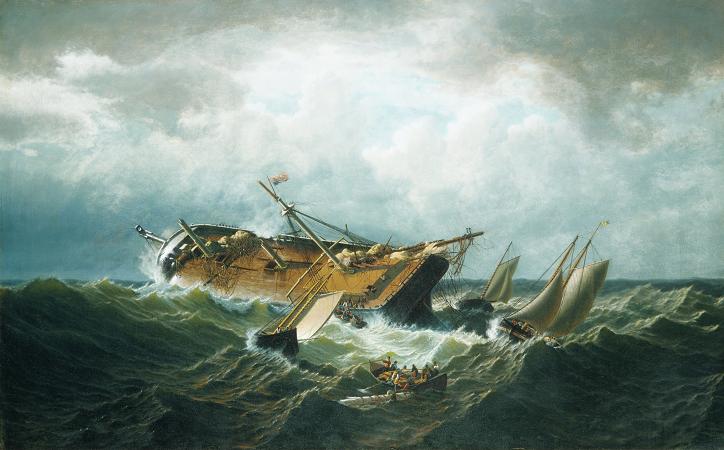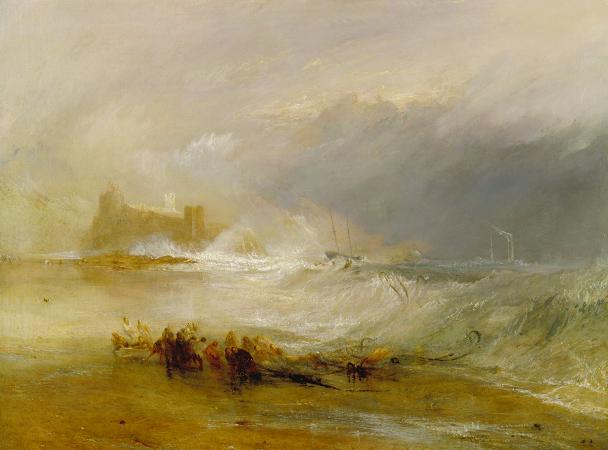Seascape with Shipwreck. A shipwreck is the remains of a ship that has wrecked, which are found either beached on land or sunken to the bottom of a body of water. Shipwrecking may be deliberate or accidental. In January 1999, Angela Croome estimated that there have been about three million shipwrecks worldwide. Historic wrecks are attractive to maritime archaeologists because they preserve historical information: for example, studying the wreck of Mary Rose revealed information about seafaring, warfare, and life in the 16th century. Military wrecks, caused by a skirmish at sea, are studied to find details about the historic event; they reveal much about the battle that occurred. Discoveries of treasure ships, often from the period of European colonisation, which sank in remote locations leaving few living witnesses, such as Batavia, do occur as well.Some contemporary wrecks, such as the oil tankers Prestige or Erika, are of interest primarily because of their potential harm to the environment. Other contemporary wrecks are scuttled in order to spur reef growth, such as Adolphus Busch and Ocean Freeze. Wrecks like Adolphus Busch and historic wrecks such as Thistlegorm are of interest to recreational divers that dive to shipwrecks because they are interesting to explore, provide large habitats for many types of marine life, and have an interesting history. Well known shipwrecks include the catastrophic Titanic, Britannic, Lusitania, Estonia, Empress of Ireland, Andrea Doria, or Costa Concordia. There are also thousands of wrecks that were not lost at sea but have been abandoned or sunk. These abandoned, or derelict ships are typically smaller craft, such as fishing vessels. They may pose a hazard to navigation and may be removed by port authorities. Main article: Shipwrecking Poor design, improperly stowed cargo, navigation and other human errors leading to collisions, bad weather, fire, and other causes can lead to accidental sinkings. Intentional reasons for sinking a ship include: intending to form an artificial reef; destruction due to warfare, piracy, mutiny or sabotage; using the vessel for target practice; or removing a menace to navigation. A ship can be also used as breakwater structure. Many factors determine the state of preservation of a wreck: the ship's construction materials. the wreck becoming covered in sand or silt. the salinity of the water the wreck is in. the level of destruction involved in the ship's loss. whether the components or cargo of the wreck were salvaged. whether the wreck was demolished to clear a navigable channel. the depth of water at the wreck site. the strength of tidal currents or wave action at the wreck site. the exposure to surface weather conditions at the wreck site. the presence of marine animals that consume the ship's fabric. temperature. the acidity, and other chemical characteristics of the water at the site. The above-especially the stratification and the damages caused by marine creatures-is better described as stratification and contamination of shipwrecks. The stratification not only creates another challenge for marine archaeology, but also a challenge to determine its primary state, i.e. the state that it was in when it sank. Stratification includes several different types of sand and silt, as well as tumulus and encrustations. These sediments are tightly linked to the type of currents, depth, and the type of water, which implies any chemical reactions that would affect potential cargo. Besides this geological phenomenon, wrecks also face the damage of marine creatures that create a home out of them, primarily octopuses and crustaceans. These creatures affect the primary state because they move, or break, any parts of the shipwreck that are in their way, thereby affecting the original condition of amphorae, for example, or any other hollow places. Finally, in addition to the slight or severe destruction marine animals can create, there are also external contaminants, such as the artifacts on and around the wreck at Pickles Reef and the over-lapping wrecks at the Molasses Reef Wreck, or contemporary pollution in bodies of water, that severely affect shipwrecks by changing the chemical structures, or further damaging what is left of a specific ship. Despite these challenges, if the information retrieved does not appear to be sufficient, or a poor preservation is achieved, authors like J.A. Parker claim that it is the historical value of the shipwreck that counts as well as any slight piece of information or evidence that is acquired. Exposed wooden components decay quickly.
more...














